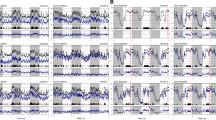Abstract
The startle response to an auditory atimulus was potentiated by treatment with d-amphetamine sulfate. Administration of l-dopa after pretreatment with the extracerebral decarboxylase inhibitor MK-486 also increased startle activity. After long-term exposure to amphetamine the startle response to l-dopa and d-amphetamine was enhanced. These findings are consistent with the consequences of longterm amphetamine administration on other amphetamine-induced behaviors (e.g. stereotypy), and are discussed in terms of the effects of long-term amphetamine treatment on pre-and postsynaptic dopamine receptors and serotonin.
Similar content being viewed by others
References
Bunney WE, van Kammen DP, Post RM, Garland BL (1979) A possible role for dopamine in schizophrenia and manic-depressive illness: A review of evidence. In: Usdin E, Kopin U, Barchas J (eds) Catecholamines: Basic and clinical frontiers. Raven, New York, pp 1807–1819
Carlton PL, Advokat C (1973) Attenuated habituation due to parchlorophenylalanine. Pharmacol Biochem Behav 1:657–663
Connell PH (1958) Amphetamine psychosis. Oxford University Press, London
Crow TJ (1979) Catecholamine reward pathways and schizophrenia: The mechanism of the antipsychotic effect and the site of the primary disturbance. Fed Proc 38:2462–2467
Davis M (1980) Neurochemical modulation of sensory-motor reactivity: Acoustic and tactile startle reflexes. Neurosci Biobehav Rev 4:241–263
Davis M, Astrachan DI, Kass E (1980) Excitatory and inhibitory effects of serotonin on sensorimotor reactivity measured with acoustic startle. Science 209:521–523
Davis M, Svensson TH, Aghajanian GK (1975) Effects of d-and l-amphetamine on habituation and sensitization of the acoustic startle response in rats. Psychopharmacologia 43:1–11
Ellison G, Eison MS, Huberman HS (1978) Stages of constant amphetamine intoxication: Delayed appearance of abnormal social behaviors in rat colonies. Psychopharmacology 56:293–299
Fechter LD (1974) The effect of l-dopa, clonidine and apomorphine on the acoustic startle reaction in rats. Pharmacol Biochem Behav 2:161–172
German DC, Bowden DM (1974) Catecholamine systems as the neural substrate for intracranial self-stimulation: A hypothesis. Brain Res 73:381–419
Griffith J, Cavanaugh J, Held J, Oates J (1972) Dextroamphetamine: Evaluation of psychomimetic properties in man. Arch Gen Psychiatry 26:97–100
Hartmann E (1976) Schzophrenia: A theory. Psychopharmacology 49:1–15
Howlett DR, Nahorski SR (1979) Acute and chronic amphetamine treatments modulate striatal dopamine receptor binding sites. Brain Res 161:173–178
Kalant O (1973) The amphetamines: Toxicity and addiction. University of Toronto Press, Toronto
Kokkinidis L, Anisman H (1978) Involvement of norepinephrine in startle arousal after acute and chronic d-amphetamine administration. Psychopharmacology 59:285–292
Kokkinidis L, Anisman H (1980) Amphetamine models of paranoid schizophrenia: An overview and elaboration of animal experimentation. Psychol Bull 88:551–579
Kokkinidis L, Anisman H (1981) Amphetamine psychosis and schizophrenia: A dual model. Neurosci Biobehav Rev 5:449–461
Kokkinidis L, Zacharko RM (1980a) Enhanced self-stimulation responding from the substantia nigra after chronic amphetamine treatment: A role for conditioning factors. Pharmacol Biochem Behav 12:543–547
Kokkinidis L, Zacharko RM (1980b) Response sensitization and depression following long-term amphetamine treatment in a self-stimulation paradigm. Psychopharmacology 68:73–76
Kokkinidis L, Zacharko RM (1980c) Enhanced lateral hypothalamic self-stimulation responding after chronic exposure to amphetamine. Behav Neural Biol 29:493–497
Muller P, Seeman P (1979) Presynaptic subsensitivity as a possible basis for sensitization by long-term dopamine mimetics. Eur J Pharmacol 149–157
Post RM (1975) Cocaine psychosis: A continuum model. Am J Psychiatry 132:225–231
Robertson A, Mogenson GJ (1979) Facilitation of self-stimulation of the prefrontal cortex in rats following chronic administration of spiroperidol or amphetamine. Psychopharmacology 65:149–154
Segal DS, Janowsky DS (1978) Psychostimulant-induced behavioral effects: Possible models of schizophrenia. In: Lipton A, Dimascio A, Killman F (eds) Psychopharmacology: A generation of progress. Raven, New York, pp 1113–1123
Snyder SH (1973) Amphetamine psychosis: A model schizophrenia mediated by catecholamines. Am J Psychiatry 130:61–68
Trulson ME, Jacobs BL (1979) Chronic amphetamine administration to cats: Behavioral and neurochemical evidence for decreased central serotonergic function. J Pharmacol Exp Ther 211:375–384
Trulson ME, Jacobs BL (1980) Chronic amphetamine administration decreases brain tryptophan hydroxylase activity in cats. Life Sci 26:329–335
Author information
Authors and Affiliations
Rights and permissions
About this article
Cite this article
Kokkinidis, L., MacNeill, E.P. Potentiation of d-amphetamine and l-dopa-induced acoustic startle activity after long-term exposure to amphetamine. Psychopharmacology 78, 331–335 (1982). https://doi.org/10.1007/BF00433736
Received:
Accepted:
Issue Date:
DOI: https://doi.org/10.1007/BF00433736




